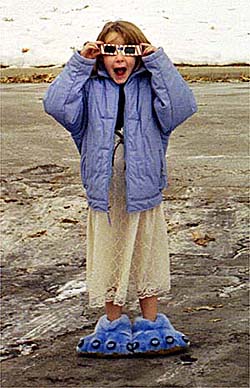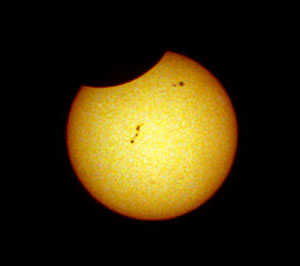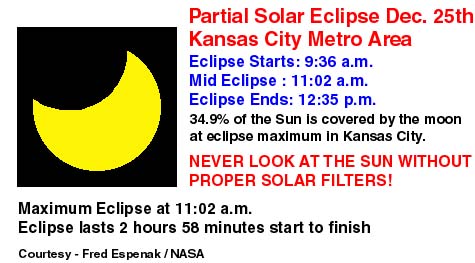

Bad weather hampers viewing
THE CHRISTMAS ECLIPSE in Kansas City


Bad weather hampers viewing
THE CHRISTMAS ECLIPSE in Kansas City
On Christmas Day, December 25, 2000, a partial solar eclipse occurred and was visible from Kansas City and across the United States, Canada and parts of Mexico and Caribbean.
Unfortunately, a large parts of the viewing area were under clouds, snow and ice.
Here in the Kansas City area the clouds were quite heavy and only brief glimpses were possible during the first half of the eclipse. With the Christmas packages open we packed up the family and headed south towards what appeared to be a brighter spot in the sky. Minutes ticked off as we drove toward the sunlight and the eclipse proceeded without us. About 40 miles south of the metro area we broke into a five mile wide patch of hazy but clear sky. We were able to shoot a few photos before the gap closed. With temperatures hovering near 10 degrees (F) and winds gusting to more than 20 mph photographing the eclipse was not a pleasant experience. It was best viewed with eclipse glasses INSIDE the warm van! The photograph above- right was shot with a 500 mm lens, hand held with a type II glass solar filter. Exposure was 250th sec. on Fuji 200 color negative film about 1 hour past maximum for our area. (12 noon, local standard time) Our daughter Libby took a break above- left to catch a glimpse of the eclipse in the driveway while dressed in her new Christmas dress and new house slippers.
Improper viewing of the eclipse can damage eyes or cause blindness. The light from a partially eclipsed Sun is not more dangerous than normal. Our Sun is always dangerous to view. Yet with a few simple precautions, everyone will be able to enjoy this exciting event safely. These are some guidelines to remember whenever observing the sun:
![]() NEVER - stare directly at the sun without an industry approved filter or glasses.
NEVER - stare directly at the sun without an industry approved filter or glasses.
![]() NEVER - look through a telescope, binoculars or camera at the sun without a special solar telescope filter.
NEVER - look through a telescope, binoculars or camera at the sun without a special solar telescope filter.
![]() NEVER - look through a telescope, binoculars or camera while wearing solar observing glasses.
NEVER - look through a telescope, binoculars or camera while wearing solar observing glasses.
![]() NEVER - look through smoked glass, exposed color film, sunglasses or other objects that darken the appearance of the sun. They offer no protection from harmful solar radiation.
NEVER - look through smoked glass, exposed color film, sunglasses or other objects that darken the appearance of the sun. They offer no protection from harmful solar radiation.
![]() ALWAYS - look with approved glass or mylar astronomical solar filters. Number 14 welders glass is also acceptable.
ALWAYS - look with approved glass or mylar astronomical solar filters. Number 14 welders glass is also acceptable.
We suggest that viewers either watch the eclipse with either the pinhole projection method. ( This is done by punching a pin-hole in one end of a shoe-box and watching its image as it appears on the opposite wall of the box. Click HERE for photos and instructions on how to build an eclipse box! ) or by wearing industry approved solar observing glasses.
They are very inexpensive at $1-3 a pair, and are readily available.

Wonder what the eclipse will look like from your location?
Click the graphics for a bigger view.
Limited Eclipse presentations are available to schools in the Kansas City metro area until December 22, 2000. Contact Jen at (660)747-9458. Slide shows are free of charge and supported by donations to the StarGarden Foundation.